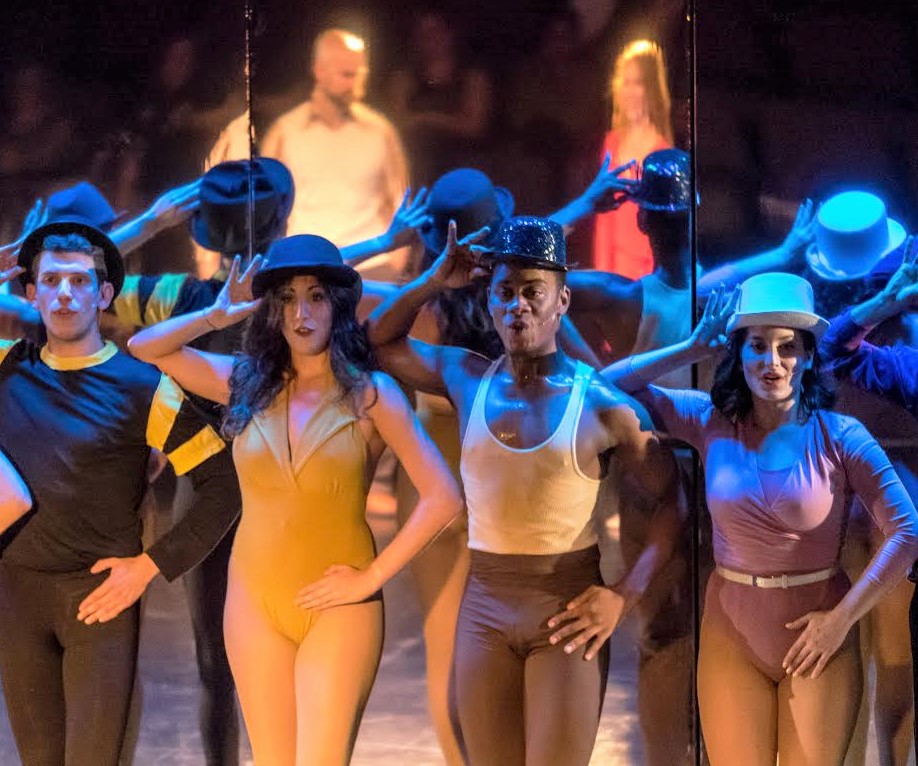Review of A Chorus Line, Playhouse on Park
A Pulitzer Prize winner in 1976, A Chorus Line, book by James Kirkwood, Jr., and Nicholas Dante, isn’t much of a play. More even than most musicals, it only works because of the songs—music by Marvin Hamlisch and lyrics by Edward Kleban—and the dance routines. That’s fitting, since the play is about the hopes and humiliations, the joys and defeats of trying to maintain a career as a chorus line dancer. I imagine its main claim to distinction, back in the Seventies, was in its humanizing of the usually faceless professionals whose precision forms the undeviating oneness of the quintessential Broadway chorus line. In pursuing that theme, rather relentlessly, the play puts real life on the stage while maintaining the romance with the stage that drives the show’s aspirants.
Zach (Eric S. Robertson, in white vest) with assistant Larry (Spencer Pond), and the cast of A Chorus Line (photo: Rich Wagner)
The play’s claim on our attention now, in a mostly non-professional production at Playhouse on Park, directed by co-artistic directors Sean Harris and Darlene Zoller, with choreography by Zoller, is the way it puts its dancers through paces that impress us with their facility in such an intimate space. We do feel like a fly on the wall of the rehearsal room as try-outs take place, governed by Zach (Eric S. Robertson), who is mostly humorless, detached, and unsympathetic. Even when confronted by a former lover, Cassie (Michelle Pruiett), who has had some star turns without becoming a star and wants to come back to the chorus line, though not back to him, Zach never becomes a character. Cassie fairs a bit better—she at least gets a great dance routine to express herself with—but the lack of real interest in their story is evident in the script itself. All the show’s interest lies in the tell-all autobiographies Zach manages to elicit from his auditioning group.
Cassie (Michelle Pruiett), solo dance routine (photo: Rich Wagner)
After first pruning a few from the opening routine, Zach has 17 to choose from for a cast of 8, four men and four women. That means a harsh principle of selection will apply, and his coercing of personal info from the dancers can seem awfully manipulative, given that most of them won’t be getting a job. The power play behind theater is always in evidence, and the degree to which the successful candidates here must both expose and efface themselves is what drives the drama.
As do the stories we hear: a few are amusing and upbeat, such as the stellar moves Mike (Alex Polzun) puts into “I Can Do That,” or Bobby (Peej Mele)’s dry take on growing up in Buffalo, or a charming tale of teen cluelessness from Mark (Jared Starkey); others are ironic, as in Val (Andree Buccheri)’s take on the part looks play in a successful stage career (“Dance: Ten, Looks: Three”), or Diana (Bobbi Barricella)’s tale of rejection by an early theater teacher (“Nothing”), or simply comic—Kristine (Mallory Cunninghams)’s song, abetted by her husband Al (Jeremy Seiner), in which she proves she can’t sing (“Sing”); then there’s Sheila (Tracey Mellon)’s tale of a rough home life juxtaposed with the enthrallment of performance (“At the Ballet”), or Paul (Tino Ardiente)’s tale of how his work in a drag review provoked his inadvertent coming-out to his parents. Because the stories keep close to what actual people might reveal of themselves, they manage to avoid outright cliché, though the influence of A Chorus Line is bound to make the stories feel familiar even if you haven’t seen the show before. But the reason to see it again is to see how a new battery of try-outs take to the parts.
Most are well-cast, and most acquit themselves well, though sometimes lyrics become a bit unintelligible, whether that’s due to the quality of the mics each performer wears or to the fact that it’s easy to get breathless when singing and dancing simultaneously. In the end, you may not agree with Zach’s selection of the final 8, but that will have to do with how you respond to the individual characters, and probably the individual actors, and that’s probably the point. Mellon’s Sheila, for instance, doesn’t make the cut, but she’s certainly an asset to this production, while other choices, such as Richie (Ronnie Bowman, Jr.), are no-brainers.
Greg (Max Weinstein), Sheila (Tracey Mellon), Richie (Ronnie Bowman, Jr.), Judy (Cara Rashkin), and the cast of A Chorus Line (photo: Rich Wagner)
As a tribute to the trials of playing anonymous parts in big shows, the show draws in viewer sympathy and the rousing number “What We Do For Love,” led by Barricella’s lovely voice, moves beyond any sense of exploitation as we realize that the fictional cast’s participation is not about money or fame or even a secure career; it’s about love of the work and of performing. Without a show in which to show off their skills and talents, these performers have nothing but the mostly drab lives they narrate. The contrast between their humble origins and their talent is the point. The Playhouse production, in using students—several now or recently at the Hartt School—and non-professionals, underscores that the talent to perform is what drives theater. And the relative inexperience of the cast makes the characters’ roles as naive hopefuls all the more convincing, and their talented turns all the more impressive.
A Chorus Line
Conceived and originally directed and choreographed by Michael Bennett
Book by James Kirkwood and Nicholas Dante
Music by Marvin Hamlisch
Lyrics by Edward Kleban
Directed by Sean Harris and Darlene Zoller
Music Directors: Emmett Drake and Michael Morris
Choreographer: Darlene Zoller; Costume Designer: Lisa Steier; Assistant Choreographer: Spencer Pond; Lighting Designer: Christopher Bell; Scenic Designer: Christopher Hoyt; Sound Designer: Joel Abbott; Properties Master: Pamela Lang
Playhouse on Park
June 15—July 31, 2016


